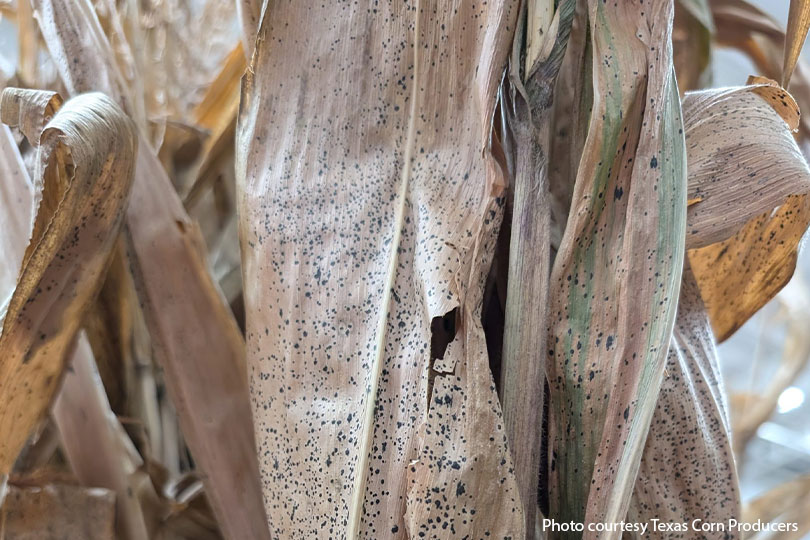By Emmy Powell
Communications Specialist
Seasonal fall corn décor sold at large retailers across Texas has been identified to be infested with Phyllacora maydis fungus, also known as tar spot.
Tar spot does not affect humans or animals, but it can be costly to the Texas corn crop.
“This does not have pose any harm to humans or pets, but it does pose a threat to introducing a disease that we currently do not have into a corn crop here in Texas,” David Gibson, executive director of the Texas Corn Producers, said. “Normally, the tar spot disease has been more isolated to the Northern Corn Belt in particular, and a lot of that’s due to their climate. That’s where these infected decorative corn plants have come from.”
Texas A&M AgriLife Research scientists have confirmed that infected corn has been sold at multiple large retailers across the state.
The disease has been identified in Texas, Arkansas and Oklahoma.
Dispose of infected corn
To prevent tar spot from spreading to the Texas crop, it is important to dispose of the corn décor properly.
“We need to dispose of it correctly and try to ensure we don’t introduce it into our environment where it would be an issue for our corn farmers requiring some type of control for the fungus, and ultimately, loss of yield and loss of money to our farmers,” Gibson said.
To properly dispose of the infected corn, place it in a heavy-duty trash bag and seal or tie the bag before throwing it away. Texas Corn Producers notes it’s important not to compost the corn.
“When you dispose of them, do not compost them. Do not mulch. Do not lay them out in your flower beds or gardens and leave them to decay That’s where the spores would formulate, and the fungus would continue to be there and potentially come out next spring,” Gibson told the Texas Farm Bureau Radio Network. “
“Disposing of the infested corn properly can help keep next year’s corn crop healthy and not impacted by this pathogen that can devastate a corn farm.”
Identifying infected corn
Tar spots can be identified as black or “frog eye” spots on corn husks.
“If the leaf on the dried corn has small, circular black specs, you can positively identify them. There will generally be multiple small, circular black spots on that leaf or stalk,” Gibson said.
The Texas Corn Producers provides examples of what it looks like. Click here to see the images.
Tar spot has not impacted Texas until this year.
“This is the first time in any form or fashion that we’ve had this identified here in Texas,” he said. “We’re hopeful that infected corn will be destroyed correctly and that hopefully our winter and spring weather will not be conducive to letting it multiply and go reproduce and become a problem out in our fields. We’re really hoping homeowners and folks that have bought this will be very diligent in helping us dispose of this in a way to prevent that from happening.”
If spores are released in the Texas corn, there are ways to control it, but it could be costly.
“If it gets identified properly and on time, there are certain fungicides that can be used to control it,” Gibson said. “But anytime we have to make applications and purchase crop protection chemicals that keeps that input cost going up for that farmer. If it gets missed, it’s certainly going to cause a decrease in their yield and production in their fields.”
Visit texascorn.org/tarspot-decorcorn/ for more information on tar spot in Texas.


Leave A Comment